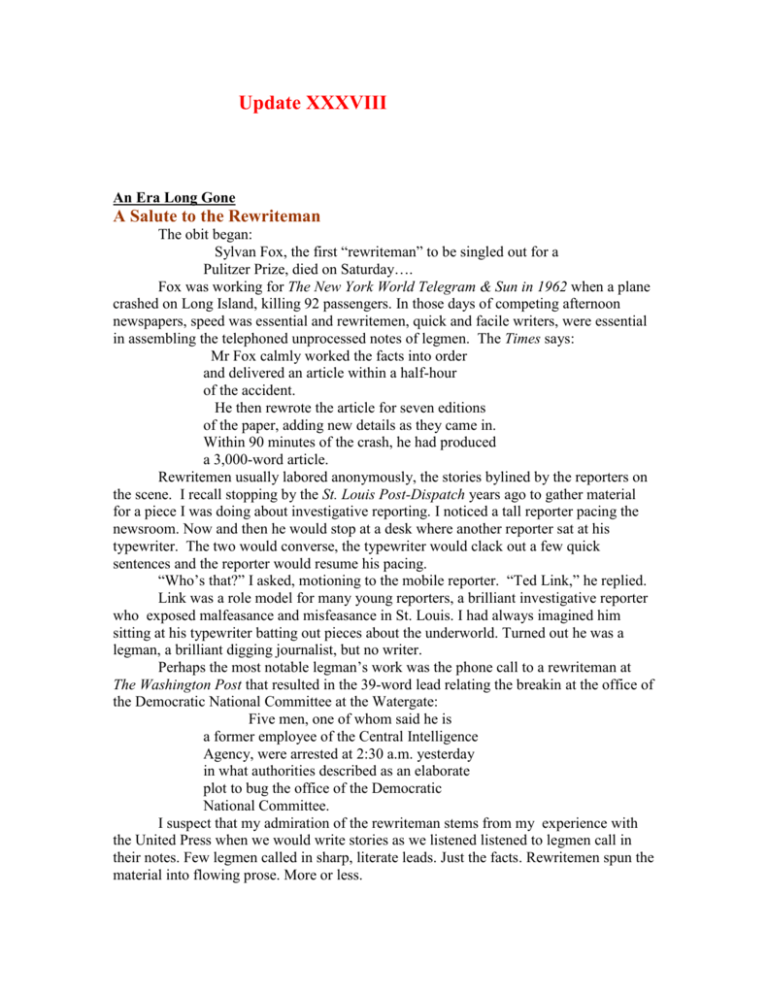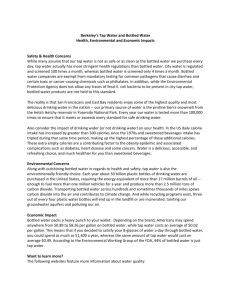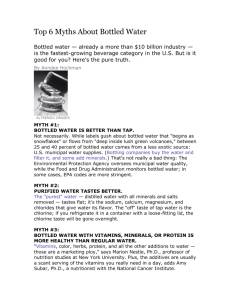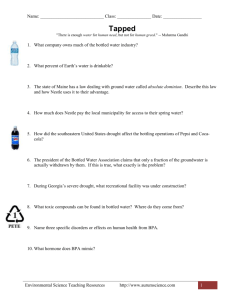Update XXXVII1
advertisement

Update XXXVIII An Era Long Gone A Salute to the Rewriteman The obit began: Sylvan Fox, the first “rewriteman” to be singled out for a Pulitzer Prize, died on Saturday…. Fox was working for The New York World Telegram & Sun in 1962 when a plane crashed on Long Island, killing 92 passengers. In those days of competing afternoon newspapers, speed was essential and rewritemen, quick and facile writers, were essential in assembling the telephoned unprocessed notes of legmen. The Times says: Mr Fox calmly worked the facts into order and delivered an article within a half-hour of the accident. He then rewrote the article for seven editions of the paper, adding new details as they came in. Within 90 minutes of the crash, he had produced a 3,000-word article. Rewritemen usually labored anonymously, the stories bylined by the reporters on the scene. I recall stopping by the St. Louis Post-Dispatch years ago to gather material for a piece I was doing about investigative reporting. I noticed a tall reporter pacing the newsroom. Now and then he would stop at a desk where another reporter sat at his typewriter. The two would converse, the typewriter would clack out a few quick sentences and the reporter would resume his pacing. “Who’s that?” I asked, motioning to the mobile reporter. “Ted Link,” he replied. Link was a role model for many young reporters, a brilliant investigative reporter who exposed malfeasance and misfeasance in St. Louis. I had always imagined him sitting at his typewriter batting out pieces about the underworld. Turned out he was a legman, a brilliant digging journalist, but no writer. Perhaps the most notable legman’s work was the phone call to a rewriteman at The Washington Post that resulted in the 39-word lead relating the breakin at the office of the Democratic National Committee at the Watergate: Five men, one of whom said he is a former employee of the Central Intelligence Agency, were arrested at 2:30 a.m. yesterday in what authorities described as an elaborate plot to bug the office of the Democratic National Committee. I suspect that my admiration of the rewriteman stems from my experience with the United Press when we would write stories as we listened listened to legmen call in their notes. Few legmen called in sharp, literate leads. Just the facts. Rewritemen spun the material into flowing prose. More or less. In those days, we battled the Associated Press for play, and woe the reporterrewrite team that was behind AP by 60 seconds on a breaking story. That minute meant UP could lose play in a newspaper and on air. The loss was chronicled to our shame in a weekly roundup of our achievements and our blunders. Metropolitan newspapers also waged war. Three, four of the city’s papers fought for advantage edition by edition. “Put a new top on it,” an editor would order staffers every hour or two. Did some detective suggest a new suspect? However slight, lead with it. Did the storm bypass the city? Get someone to suggest how many lives were saved. Has the investigating committee clammed up? Find someone to speculate about the reason. These were the makings of the “war stories” that reporters-turned-journalism instructors were told to avoid using in the classroom. Maybe one or two to illustrate a teaching point, we were told. I could understand the reason for the warning after I heard students at Columbia complain about their reporting instructor--the former editor of a newsweekly--who regaled his students week after week with his exploits. Thirst Quencher Exercise Drink Preferences: Bottled or Tap Water, Soda, Milk… Here’s an assignment your students might enjoy: What do people drink when they’re thirsty or want a drink to go along with a meal? The assignment combines interviewing with basic math calculations. Or you can present the material as a class exercise. The Drinking Data The first two columns below compare average annual consumption in gallons of 10 years ago with current consumption. The third column lists the percentage change in the decade. You could ask your students to derive the percentages. The figures are from the Beverage Digest. Today 10 Years Ago Percentage Change Soft drinks 51 55 -7.3 Water 48 42 +14.3 Tap 27 31 -12.9 Bottled 21 11 +90.9 Beer 22 24 -8.3 Milk 20 22 -9.1 Coffee 16 20 -11.1 Juices 8 9 -20 Sports drinks 5 2 +150 Others 10 9 +66.7 Summary The bottled water industry says its latest figures show bottled water is on equal footing with tap water, 27 gallons a year. If you want to substitute 27 for the 21 figure above, the percentage change would then be +145 percent. For the story, the significant increase is in bottled water. Although it is 2,800 times more expensive than tap water--$1,400 a year compared with 50 cents for tap water--the cost deters few. Only lately have bottled-water users seemed concerned about the effect on the environment of millions of discarded water bottles. Only a fourth are recycled. Manufacturing the plastic bottles consumes 1.5 million barrels of petroleum a year. Assignment Ask those who prefer bottled water why they buy it when, studies show, it is not as carefully monitored as local tap water. Some tap water is so pure—Boston, New York, San Francisco, Seattle, Portland, Ore.—it isn’t filtered. Forty percent of all bottled water is filtered tap water. Voting Age How About 16? Some countries (Austria, Brazil, Cuba, Nicaragua) have lowered their voting age to 16, and there is some sentiment in the U.S. to follow suit. Ruthanne Kurth-Schai of Macalaster College says allowing 16-year-olds to vote would help “in supporting the development of young people” and would promote a “deeper, more inclusive form of democracy.” Leon Botstein, president of Bard College, says, “Yesterday’s 18-year-olds are today’s 16-year-olds.” The dissenters say that the lack of maturity and experience disqualifies the young voter. Curtis Gans, director of the Center of the American Electorate at American University, says that 16-year-olds are not “mature enough to nmake voting judgments because they don’t have any historical perspective and they don’t have any comparable civic responsibility.” Not that there would be many 16-year-old voters, if the voting of 18-year-olds, who were given the right to vote in 1971, is any barometer. Fewer than half (47 percent) of those 18 to 24 voted in the 2004 presidential election. This compares with: 25-34 56 percent 35-44 64 45-54 69 55-64 73 over 65 71 Assignment: Should 16-year-olds be given the right to vote? Interview different groups and blend their responses with the above data: students, faculty members, townspeople. Questions of Taste In this Age of Candor, What’s Taboo? The Sunday education section of The New York Times recently ran a short piece on school slogans. To illustrate the article, the paper reproduced several T-shirts with the slogans. Here are four: KENYON IS NOT NEAR UGANDA WOOSTER IS NOT IN MASSACHUSETTS SWARTHMORE:Anywhere else it would have been an A..really A CENTURY OF WOMEN ON TOP Smith College Centennial 1875-1975 The Times story includes this sentence: “The double entendre celebrating Smith’s Centennial—the winner of a slogan contest—is still quoted more than 30 years later.” That staunch guardian of good taste running a double entendre? I asked a Times editor how come. She told me it passed the desk because of the “audience for the section, college students and educators. It probably would not have run in the news section.” Yes, the grey lady tossed away her bonnet a while back, but some of us are surprised that her granddaughter keeps a miniskirt in the closet for occasional use. Cheney’s Language The Times concedes that on matters of taste it has narrower boundaries than most, if not all, metropolitan newspapers. For example, after a campaign rally in Naperville, Ill., the microphone was inadvertently left open and the following dialogue could be heard: George W. Bush: “There’s Adam Clymer, major league asshole from The New York Times.” Richard Cheney: “Oh, yeah. He is, big time.” The Washington Post and the Los Angeles Times printed the vulgarity as spoken. Not the Times. That was a while back. Would asshole make it today? “No, not unless there was a more relevant context than its being uttered against a reporter,” an editor told me. More recently, the vice president was again the subject of a study in bad taste. In response to comments on the Senate floor by Sen. Patrick Leahy, Cheney told the senator to “go fuck yourself.” The Washington Post ran the quote untouched. But in The New York Times Cheney’s words appeared as “an obscene phrase to describe what he thought Mr. Leahy should do.” Obviously, the four-letter expletive is taboo at the Times, whatever the context. The newspaper’s social news section regularly runs wedding announcements that include the fact that the newlyweds have been living together for three or four years, and its Sunday wedding feature sometimes shows photos of bride and groom, with the bride well advanced in pregnancy. But it is words that bother the newspaper. The newspaper’s stylebook has a high fence for words considered obscene, vulgar or profane. It states that “exceptions have been made only a handful of times,” and it cities the 1974 Watergate White House conversations, the 1991 hearings for Supreme Court nominee Clarence Thomas and the 1998 Starr report on the impeachment of President Clinton. Tight Boundaries Then Just what are the limits for questionable language and stark subject matter? In the new edition of News Reporting and Writing I trace the changes in what constitutes the permissible in print and broadcast, from the constricting taboos to the wide latitude allowed at most publications today. Years ago, the Chicago Tribune prohibited the word rape in its columns, which led a frustrated reporter to write that a rape victim ran down the street shouting, “Help! Help! I’ve been criminally assaulted.” Obits skirted identifying AIDS as a cause of death. Most newspapers would not use the word condoms. Nor would they refer to some body parts. When the Pioneer 10 spacecraft went into flight carrying a drawing of a naked man and woman to show some possible distant civilization what we look like, The Philadelphia Inquirer’s reproduction of the drawing showed the man without genitals and the woman’s breast without nipples. Greater Latitude Today Clearly, the narrow boundaries for language and subject matter no longer exist. Candor prevails. In the past, few newspapers ran photos of the severely injured and the dead. The war in Iraq has loosened the taboo about showing the grievously injured. The News & Observer in Raleigh, N.C., ran a photo of a soldier who had lost both legs and much of his right arm. He is shown lying on a hospital bed with his wife alongside shortly after their wedding. I asked the editor, Melanie Sill, whether she had received complaints. “None,” she replied. I am running the photo in the eleventh edition of News Reporting and Writing. I’m not using the photo of a severed hand that the Daily News ran in one edition following the destruction of the Twin Towers in New York on Sept. 11. The photo was pulled after staffers complained. For those who want to see the limits in this Age of Candor, the photo is available in the online ancillary NRW Plus, chapter 26, at www.mhhe.com/mencher11. Worth Quoting Ethics Writers are always selling someone out. --Joan Didion The Journalist A good journalist is a rewarding sight. He enters a trade where the pay is low, low at least for the qualities of intelligence, energy, judgment, a d talent he mist bring to it. He must have a zest for events, as accountants love figures and carpenters wood. He must have a dedication to facts and scent for the humbug. --Thomas Griffith Good Work It’s work that has three characteristics. First of all, it’s excellent in quality; it’s technically unimpeachable. Second of all, it’s personally engaging; people want to do it;’ they get meaning out of it. Third of all, it’s carried out in an ethical way. That doesn’t mean people always succeed in being ethical; nobody can bat 100 percent on ethics, but that individuals who are workers are always thinking about the implications of what they’re doping for other people and for the broader society. --Howard Gardner Assignment Students’ Religious Beliefs A polling organization asked of teen-agers: 1. Is the Bible— a) the actual word of God? b) the inspired word of God? c) an ancient book of fables, legends, history and moral precepts recorded by man? Their responses: a) 39 percent yes b) 46 percent yes c) 14 percent yes d) 2. Evolution: 81 percent believe evolution never occurred or was guided by God. 3. Agree? “God created humans pretty much in their present form within the last 10,000 years or so. 81 percent agreed. 4. The Pew Research Center found that 20 percent of 18-25-year-olds reported no religious affiliation. Assignment: How do the beliefs of students on your campus compare with these figures?




